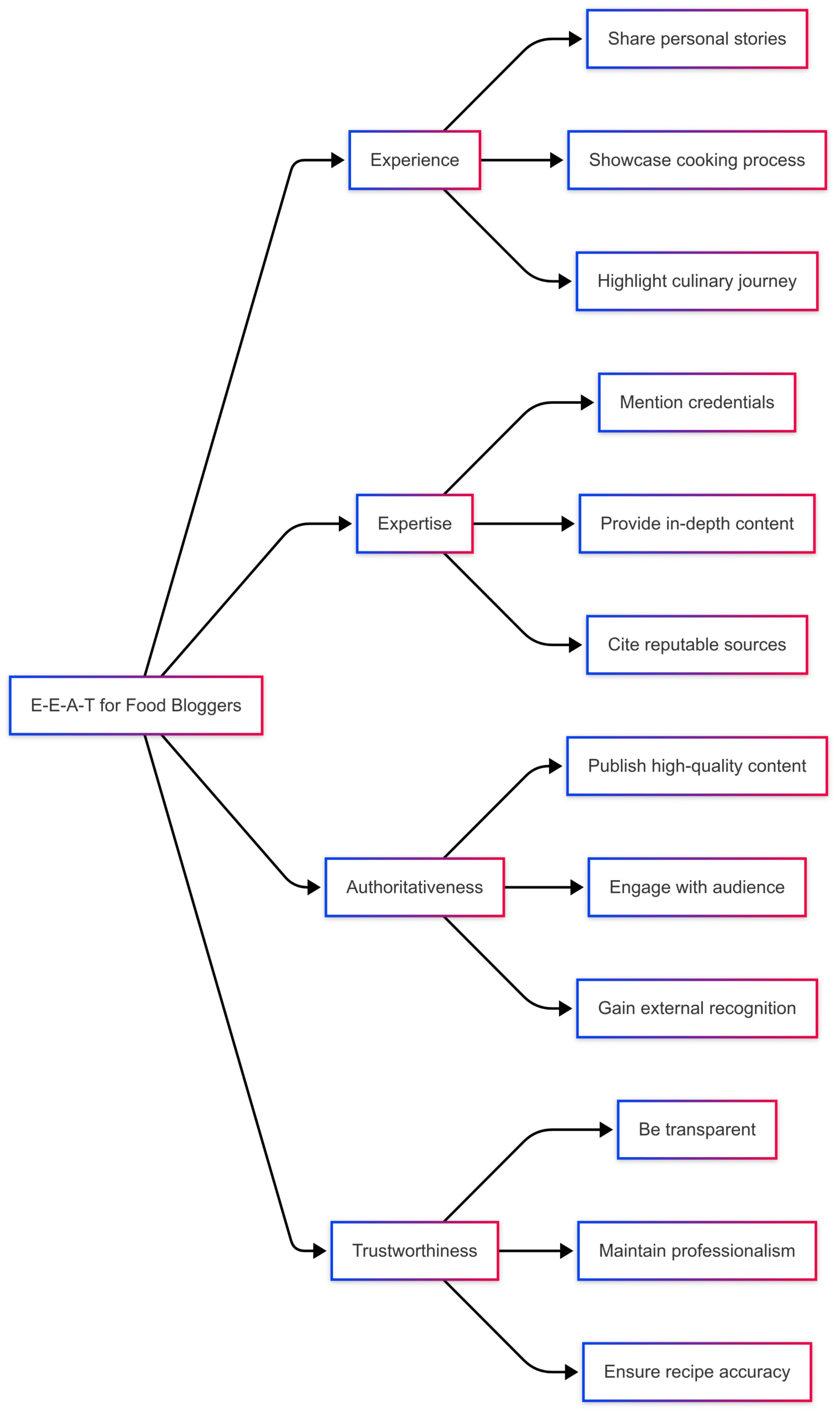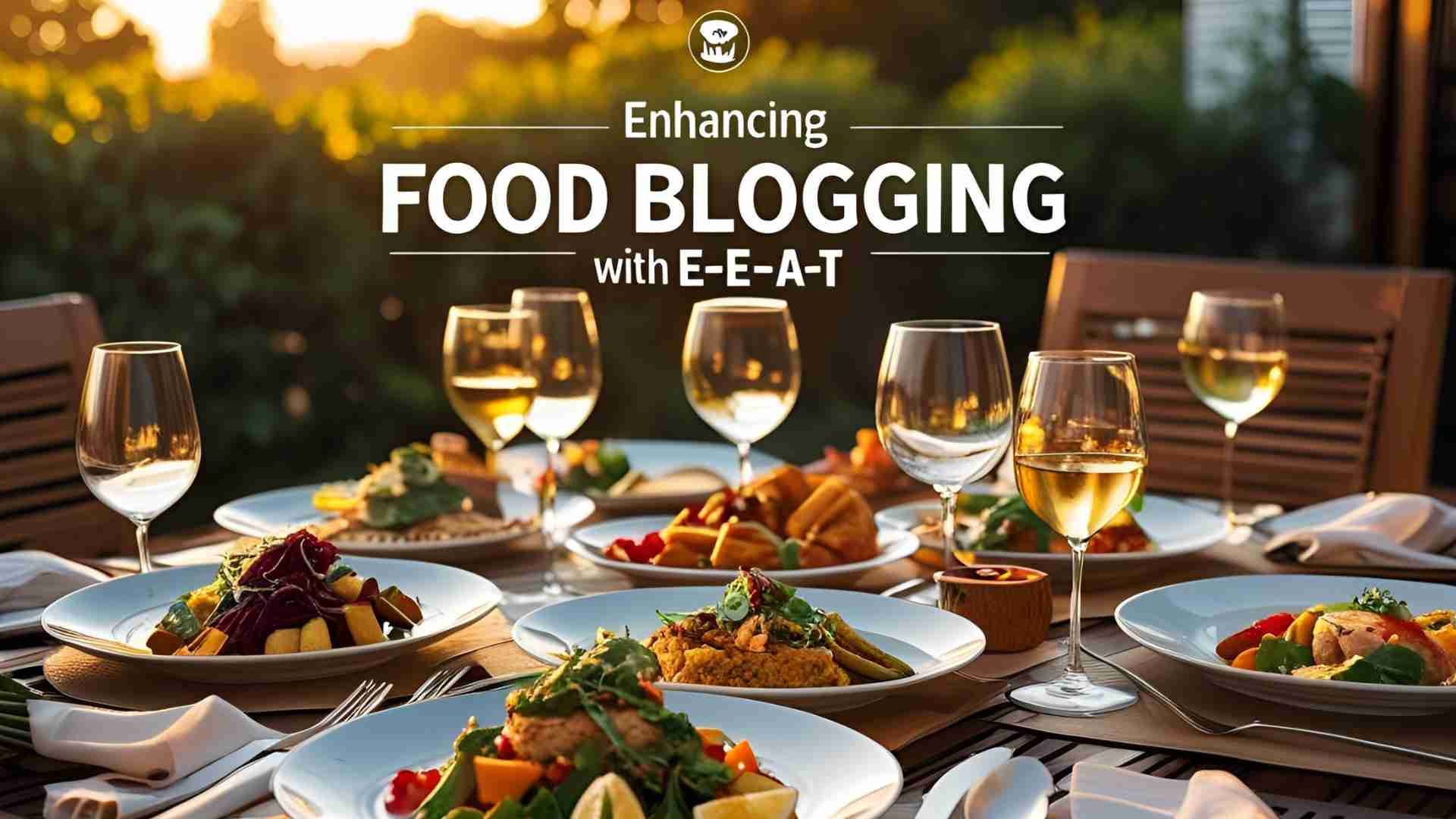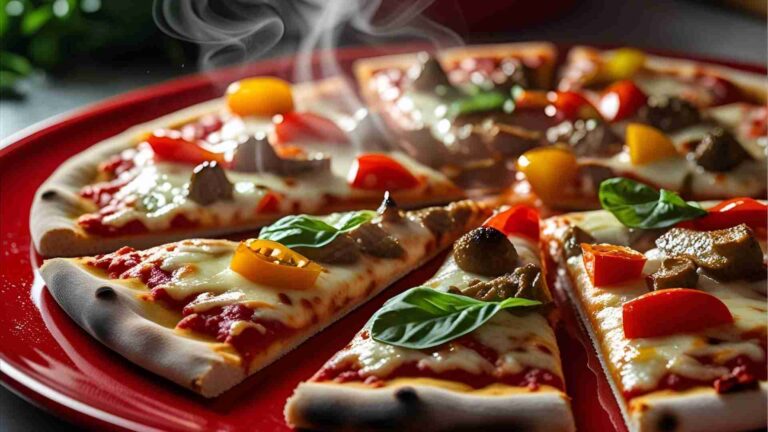For Food Bloggers: What Is E-E-A-T And Why Should I Care?
Learn how E-E-A-T (Experience, Expertise, Authoritativeness, Trustworthiness) boosts your food blog’s SEO and builds reader trust for success.
In the competitive world of food blogging, standing out requires more than just mouthwatering recipes and stunning photography. To rank well on Google and build a loyal audience, food bloggers must align their content with Google’s Quality Rater Guidelines, specifically the concept of E-E-A-T: Experience, Expertise, Authoritativeness, and Trustworthiness. These four pillars guide Google’s human quality raters in assessing content quality, particularly for topics like food, which fall under the “Your Money or Your Life” (YMYL) category due to their potential impact on health and well-being. This comprehensive guide explores what E-E-A-T means for food bloggers, why it matters, and how to implement it effectively to enhance SEO performance and reader trust, all while keeping your blog engaging and authentic.
What Is E-E-A-T?
E-E-A-T stands for Experience, Expertise, Authoritativeness, and Trustworthiness. Introduced as an evolution of the original E-A-T (Expertise, Authoritativeness, Trustworthiness), the additional “E” for Experience was added to emphasize the importance of firsthand knowledge in content creation. Google’s Quality Rater Guidelines use E-E-A-T to evaluate whether a webpage provides high-quality, reliable information that serves its audience well. For food bloggers, this framework is critical because recipes, nutritional advice, and dietary recommendations can influence readers’ health and decision-making.
Breaking Down E-E-A-T
- Experience: Demonstrates firsthand or personal knowledge of the topic. For example, a food blogger who has spent years perfecting vegan recipes or navigating gluten-free cooking due to personal dietary needs brings valuable lived experience to their content.
- Expertise: Reflects specialized knowledge or skills, often backed by credentials, training, or extensive practice. A blogger with culinary school training or a background in nutrition can showcase expertise through detailed techniques or science-backed advice.
- Authoritativeness: Establishes the blogger or their website as a recognized source in their niche. This could mean being cited by other food blogs, featured in media, or known for a specific cuisine, like Italian desserts.
- Trustworthiness: Centers on the accuracy, honesty, and reliability of the content. Transparent disclosures, secure websites, and error-free recipes build trust with readers and search engines alike.
Why E-E-A-T Matters for Food Bloggers
While E-E-A-T is not a direct ranking factor in Google’s algorithm, it influences how human quality raters assess content, which indirectly informs algorithmic updates. High E-E-A-T signals align with Google’s goal of prioritizing content that is accurate, helpful, and safe, especially for YMYL topics like food and nutrition. For food bloggers, strong E-E-A-T can:
- Improve SEO Rankings: Content that demonstrates E-E-A-T is more likely to rank higher in search results, driving organic traffic.
- Build Reader Trust: Readers are more likely to follow recipes or advice from a blog they perceive as credible and reliable.
- Future-Proof Your Blog: As Google’s algorithms evolve, prioritizing E-E-A-T helps protect against penalties from updates targeting low-quality content.
The YMYL Connection
Google classifies certain topics as “Your Money or Your Life” (YMYL) because they can significantly impact a person’s health, finances, or safety. Food blogging falls under this category, particularly when covering nutrition, dietary restrictions, or health-related claims. For instance, inaccurate advice about food allergies or nutritional benefits could harm readers, making E-E-A-T critical.
YMYL Considerations for Food Bloggers
- Health and Safety: Recipes or advice must be accurate to avoid harm. For example, suggesting unsafe ingredients or untested dietary claims can undermine trust and lead to serious consequences.
- Reliable Sourcing: Nutritional claims should be backed by reputable sources, such as peer-reviewed studies or government health guidelines.
- Transparency: Clearly distinguish between personal opinions and evidence-based advice to maintain credibility.
| YMYL Aspect | Impact on Food Blogging |
|---|---|
| Health and Safety | Inaccurate recipes or health claims (e.g., “cures” for conditions) can harm readers. |
| Financial Stability | Misleading product reviews or affiliate links can affect readers’ purchasing decisions. |
| Societal Well-Being | Promoting unsafe food practices (e.g., improper canning) can impact public health. |
How to Implement E-E-A-T in Your Food Blog
To create a food blog that excels in E-E-A-T, you need to strategically incorporate each component into your content, website design, and online presence. Below are actionable strategies, supported by examples and best practices.
1. Demonstrate Experience
Experience sets your blog apart by showing readers you’ve lived the content you’re sharing. For food bloggers, this means weaving personal stories and practical insights into your posts.
- Share Personal Stories: Connect recipes to your life. For example, describe how a family heirloom recipe shaped your love for cooking or how you adapted to a vegan diet after a health diagnosis. These narratives make your content relatable and authentic.
- Showcase Your Process: Include behind-the-scenes details, like photos or videos of your recipe testing. For instance, a video of you kneading dough for sourdough bread demonstrates hands-on experience.
- Highlight Your Journey: Share your evolution as a cook. A blogger who transitioned from novice to expert in baking gluten-free pastries can document their learning curve, making their content more engaging.
Example: The blog Handle the Heat includes a post titled “The Ultimate Guide to Chocolate Chip Cookies,” where the author shares years of testing different recipes, showcasing firsthand experience that resonates with readers.
2. Showcase Expertise
Expertise is about proving you have the knowledge and skills to create authoritative content. Food bloggers can demonstrate expertise through credentials, detailed content, and reliable sourcing.
- Highlight Credentials: On your About page or in posts, mention culinary training, certifications (e.g., food safety or nutrition courses), or professional experience in the food industry. For example, a blogger with a Le Cordon Bleu diploma can reference this to establish credibility.
- Provide In-Depth Content: Write detailed posts that explain techniques, such as the science behind emulsifying sauces or choosing the right flour for pizza dough. This shows a deep understanding of your craft.
- Cite Reputable Sources: When discussing nutrition or health (e.g., benefits of omega-3s in fish), link to credible sources like the USDA or peer-reviewed journals.
Example: Sally’s Baking Recipes offers a post on “How to Properly Measure Baking Ingredients,” which breaks down precise techniques and explains why accuracy matters, demonstrating expertise in baking.
3. Build Authoritativeness
Authoritativeness establishes you as a go-to source in your niche. For food bloggers, this involves creating high-quality content and gaining recognition within the food community.
- Publish High-Quality Content: Ensure your recipes are accurate, well-tested, and free of errors. Use clear instructions and high-quality images to enhance professionalism.
- Engage with Your Audience: Respond to comments and questions on your blog and social media. This interaction shows you’re an active, authoritative voice in your niche.
- Gain External Recognition: Write guest posts for reputable food blogs, contribute to food magazines, or appear on podcasts. Being featured on platforms like Food Network or Bon Appétit boosts your authority.
Example: A blogger who writes a column for a site like Serious Eats and links back to their own blog gains credibility through association with an authoritative platform.
4. Establish Trustworthiness
Trust is the cornerstone of E-E-A-T, as untrustworthy content undermines even the most experienced or expert voices. For food bloggers, trust is built through transparency, professionalism, and reliability.
- Be Transparent: Disclose sponsorships, affiliate links, or gifted products clearly, following FTC guidelines. For example, include a statement like, “This post contains affiliate links, which means I may earn a commission if you make a purchase.”
- Maintain Professionalism: Design a clean, user-friendly website with easy navigation and no broken links. Use an SSL certificate to ensure security (e.g., HTTPS instead of HTTP).
- Provide Accurate Recipes: Test recipes thoroughly to ensure they work as promised. Include precise measurements, cooking times, and step-by-step instructions to avoid ambiguity.
Example: Pinch of Yum includes detailed recipe notes and reader feedback in their posts, ensuring transparency and reliability.
Visualizing E-E-A-T Implementation
Below is a Mermaid chart illustrating how food bloggers can structure their efforts to incorporate E-E-A-T principles:

Practical Steps to Boost E-E-A-T
To make E-E-A-T actionable, food bloggers should integrate it into their content strategy and website management. Here are 15 practical steps to enhance your blog’s E-E-A-T:
- Create a Robust About Page: Include a high-quality headshot, your culinary background, credentials, and links to media features or publications. For example, Alexis Joseph’s Hummusapien About page highlights her dietitian credentials and media appearances.
- Add an Author Bio: Include a brief bio in your blog’s sidebar or under each post, linking to your About page. Mention relevant experience, like years of recipe development.
- Link to Authoritative Sources: When discussing nutrition or health, cite sources like the FDA, WHO, or academic journals to back claims.
- Test Recipes Thoroughly: Document your testing process to show readers your recipes are reliable. For example, The Pancake Princess details their no-bake cheesecake experiments.
- Use Structured Data: Implement recipe schema markup (via plugins like WP Recipe Maker) to help Google understand your content’s purpose.
- Write Detailed Posts: Create comprehensive posts that answer reader questions fully. For example, a post on sourdough bread could cover starter maintenance, kneading techniques, and baking tips.
- Engage on Social Media: Maintain active profiles on platforms like Instagram or Pinterest, sharing content that reinforces your expertise (e.g., recipe videos).
- Contribute to Reputable Blogs: Write guest posts for established food blogs to build authority. Avoid low-quality guest posting, which can harm your reputation.
- Showcase Your Process: Share photos or videos of you preparing recipes to demonstrate hands-on experience.
- Audit Old Content: Regularly update or delete outdated posts to maintain accuracy and relevance.
- Get Certified: Consider short courses in food safety, nutrition, or culinary arts to boost credibility.
- Encourage Reader Feedback: Include calls-to-action for comments or reviews to show engagement and trustworthiness.
- Secure Your Site: Ensure your blog uses HTTPS with an SSL certificate, available through most hosting providers.
- Create Educational Resources: Develop guides, like “How to Make Perfect Pie Crust,” to position yourself as an educator in your niche.
- Publish an eBook or Course: Create a recipe eBook or cooking course to establish authority and generate testimonials.
| Action | E-E-A-T Component | Impact |
|---|---|---|
| Create a Robust About Page | Expertise, Authority | Builds credibility with readers and search engines. |
| Test Recipes Thoroughly | Trustworthiness | Ensures recipes are reliable, enhancing reader trust. |
| Use Structured Data | Trustworthiness | Improves Google’s understanding of your content, boosting SEO. |
| Contribute to Reputable Blogs | Authoritativeness | Increases recognition as a trusted voice in the food blogging community. |
E-E-A-T and SEO: The Connection
While E-E-A-T is not a direct ranking factor, it aligns with Google’s signals for high-quality content. Human quality raters use E-E-A-T to evaluate pages, and their feedback influences algorithmic updates. For food bloggers, strong E-E-A-T can:
- Enhance SERP Performance: High-quality content is more likely to rank well, driving organic traffic.
- Improve User Experience: Authoritative, trustworthy content keeps readers engaged, reducing bounce rates and signaling quality to Google.
- Mitigate Algorithm Risks: Blogs with low E-E-A-T risk penalties during updates like Google’s “Medic” update, which targeted YMYL content.
Case Study: Impact of E-E-A-T on Rankings
A food blogger focusing on vegan recipes revamped their site by adding an About page detailing their 10 years of vegan cooking experience, linking to nutrition studies, and updating old posts. Within six months, their organic traffic increased by 30%, and several posts climbed to the first page of Google for competitive keywords like “vegan meal prep.”
Common Pitfalls to Avoid
- Overstating Expertise: Avoid claiming expertise without evidence. For example, don’t present nutritional advice as fact unless you’re a qualified dietitian.
- Ignoring YMYL Guidelines: Be cautious with health-related claims, as misinformation can harm readers and lower E-E-A-T.
- Spammy Tactics: Avoid low-quality guest posts or buying backlinks, as these can trigger Google penalties.
- Neglecting Site Maintenance: Broken links, outdated content, or an unsecured site (HTTP) can undermine trustworthiness.
Future-Proofing Your Food Blog
E-E-A-T is becoming increasingly important as Google’s algorithms grow smarter. By prioritizing high-quality, reader-focused content, you can protect your blog from future updates and build a loyal audience. Focus on:
- Continuous Improvement: Regularly audit content for accuracy and relevance.
- Authenticity: Create content that reflects your genuine experience and expertise.
- Reader-Centricity: Prioritize user experience with clear, actionable, and trustworthy content.
Conclusion
E-E-A-T is a powerful framework for food bloggers aiming to boost their SEO and build reader trust. By demonstrating experience through personal stories, showcasing expertise with credentials and detailed content, establishing authoritativeness through recognition, and ensuring trustworthiness with transparency and accuracy, you can create a blog that stands out in a crowded digital space. Implementing the strategies outlined—such as robust About pages, thorough recipe testing, and structured data—will not only align your blog with Google’s quality standards but also foster a loyal, engaged audience. Start integrating E-E-A-T today to future-proof your food blog and achieve long-term success.
Please share these For Food Bloggers: What Is E-E-A-T And Why Should I Care? with your friends and do a comment below about your feedback.
We will meet you on next article.
Until you can read, Summer Berry Fusion Smoothie Bowl






